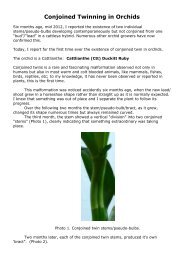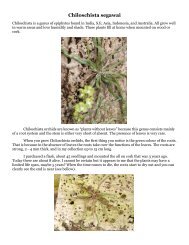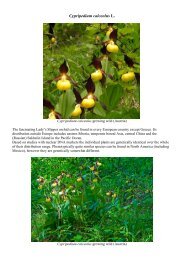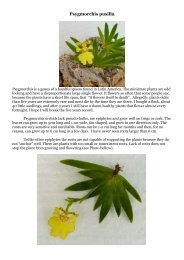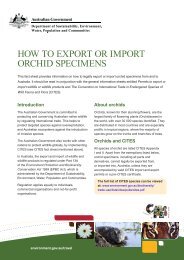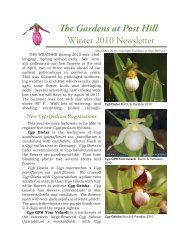P + M + S - Orchids-World
P + M + S - Orchids-World
P + M + S - Orchids-World
You also want an ePaper? Increase the reach of your titles
YUMPU automatically turns print PDFs into web optimized ePapers that Google loves.
From the above, it is very clear that the definition on “Monopod” and therefore “Monopodial” is<br />
very clear and specific. It is also very clear that the name refers to the appearance and when it<br />
comes to orchids, it does not in any way differentiate between terrestrials and epiphytes, annuals<br />
and evergreens, plants that grow from seed, cuttings or tubers. It is an ill-conceived idea that<br />
orchids with limited life span (annuals) cannot be monopodial.<br />
“Sym” is also a Greek word, a very confusing one. It is meaningless when used alone and<br />
has numerous interpretations when added to other words, as a prefix, for example: “joint”,<br />
“together”, “with”, “sharing”, etc. Words using “Sym” as a prefix are: Symbiotic, Symbolic,<br />
Symmetric, Sympathetic, Symphony, Symposium, Symptoms, etc. By definition, the word<br />
“sympodial” implies that a plant, given time, will develop into a large inter- connected, selfsupporting<br />
specimen. A specimen made up from growths of many generations all sharing the<br />
same roots, “living together” and “supporting each other”.<br />
When it comes to the definition of “sympodial”, it is almost certain that it was based on<br />
orchids not found in Europe like cattleya and catasetum. New genera were added but the<br />
definition did not change much the last 250 years.<br />
The definition “Monopodial” was probably based on terrestrial orchids found in Europe,<br />
like Ophrys, Orchis, Satyrion, etc. The definition has changed substantially to represent<br />
exclusively the vandaceous orchids. Practically, today we have two groups: Vandaceous and Non-<br />
Vandaceous. The words "monopodial" and "sympodial" are still being used; however, they have<br />
no real meaning simply because vandaceous plants are not necessarily monopodial and many<br />
non-vandaceous plants are in fact monopodial.<br />
Podial, Monopodial and Sympodial: The author’s point of View.<br />
Facts of life:<br />
All life forms are born to multiply and die. Nothing lives forever.<br />
Today’s definition of “monopodial” plants claims that monopodial plants grow forever.<br />
That is a scientifically not sound argument.<br />
All plants grow upright because plants need light.<br />
Another claim is that monopodial orchids grow upright. That is silly because it suggests<br />
that sympodial orchids do not. All plants grow upright and nothing lives forever.<br />
The true difference between a monopodial and sympodial is simple. Sympodial plants can<br />
be divided into two or more healthy independent plants, each sharing a part of the original root<br />
system and capable of surviving if planted separately. Monopodial plants, being “single stem”<br />
plants (monostemic), cannot be divided.<br />
The majority of orchids are sympodial; however, there are many genera that are<br />
monopodial and there are also orchids that are neither monopodial nor sympodial; I call them<br />
“Podial”.<br />
Podial are orchids that have no visible stems or leaves, only roots; Just legs = “Podia”.<br />
Today, this “podial” group of orchids, because of there are classified as Vandaceous, are listed as<br />
Monopodial. I hope the name will be adopted soon or later officially.<br />
Sympodial: For an orchid to be sympodial it must satisfy at least 3 main criteria if not all four.<br />
1. New growths are part of the main plant and are either attached to the main<br />
body or to the pseudo-bulbs or to bulbs. The number of new growths is NOT<br />
limited to one. Some pseudo-bulbs can produce 2-3 new growths<br />
simultaneously.<br />
2. Pseudo-bulbs, bulbs and roots are interconnected and continue to support<br />
the new growth(s) for the life of the plant.<br />
3. Sympodial orchids can be propagated by seed, division, cuttings, keikis and<br />
almost all genera can be mericloned.




